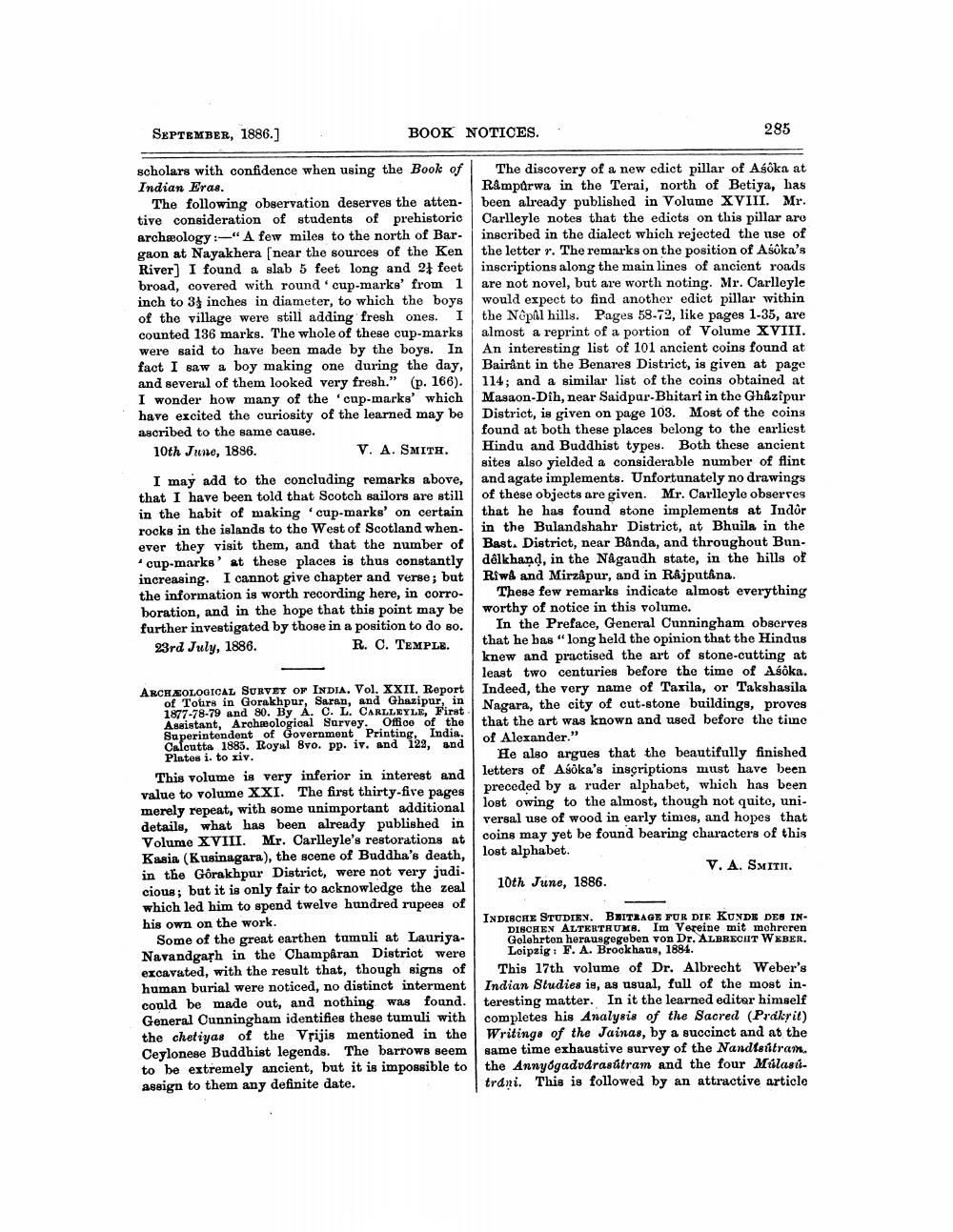________________
SEPTEMBER, 1886.]
scholars with confidence when using the Book of Indian Eras.
BOOK NOTICES.
4
The following observation deserves the attentive consideration of students of prehistoric archæology:-"A few miles to the north of Bargaon at Nayakhera [near the sources of the Ken River] I found a slab 5 feet long and 24 feet broad, covered with round cup-marks' from 1 inch to 3 inches in diameter, to which the boys of the village were still adding fresh ones. I counted 136 marks. The whole of these cup-marks were said to have been made by the boys. In fact I saw a boy making one during the day, and several of them looked very fresh." (p. 166). I wonder how many of the 'cup-marks' which have excited the curiosity of the learned may be ascribed to the same cause.
10th June, 1886.
V. A. SMITH.
I may add to the concluding remarks above, that I have been told that Scotch sailors are still in the habit of making cup-marks' on certain rocks in the islands to the West of Scotland whenever they visit them, and that the number of 'cup-marks' at these places is thus constantly increasing. I cannot give chapter and verse; but the information is worth recording here, in corroboration, and in the hope that this point may be further investigated by those in a position to do so. 23rd July, 1886. R. C. TEMPLE.
ARCHEOLOGICAL SURVEY OF INDIA. Vol. XXII. Report of Tours in Gorakhpur, Saran, and Ghazipur, in 1877-78-79 and 80. By A. C. L. CARLLEYLE, First Assistant, Archeological Survey. Office of the Superintendent of Government Printing, India. Calcutta 1885. Royal 8vo. pp. iv. and 122, and Plates i. to xiv.
This volume is very inferior in interest and value to volume XXI. The first thirty-five pages merely repeat, with some unimportant additional details, what has been already published in Volume XVIII. Mr. Carlleyle's restorations at Kasia (Kusinagara), the scene of Buddha's death, in the Gorakhpur District, were not very judicious; but it is only fair to acknowledge the zeal which led him to spend twelve hundred rupees of his own on the work.
Some of the great earthen tumuli at LauriyaNavandgarh in the Champaran District were excavated, with the result that, though signs of human burial were noticed, no distinct interment could be made out, and nothing was found. General Cunningham identifies these tumuli with the chetiyas of the Vrijis mentioned in the Ceylonese Buddhist legends. The barrows seem to be extremely ancient, but it is impossible to assign to them any definite date.
285
The discovery of a new cdict pillar of Aśoka at Ramparwa in the Terai, north of Betiya, has been already published in Volume XVIII. Mr. Carlleyle notes that the edicts on this pillar are inscribed in the dialect which rejected the use of the letter r. The remarks on the position of Asôka's inscriptions along the main lines of ancient roads are not novel, but are worth noting. Mr. Carlleyle would expect to find another edict pillar within the Nôpâl hills. Pages 58-72, like pages 1-35, are almost a reprint of a portion of Volume XVIII. An interesting list of 101 ancient coins found at Bairânt in the Benares District, is given at page 114; and a similar list of the coins obtained at Masaon-Dih, near Saidpur-Bhitari in the Ghazipur District, is given on page 103. Most of the coins found at both these places belong to the earliest Hindu and Buddhist types. Both these ancient sites also yielded a considerable number of flint and agate implements. Unfortunately no drawings of these objects are given. Mr. Carlleyle observes that he has found stone implements at Indor in the Bulandshahr District, at Bhuila in the Bast. District, near Bânda, and throughout Bundêlkhand, in the Nâgaudh state, in the hills of Riwa and Mirzâpur, and in Rajputâna.
These few remarks indicate almost everything worthy of notice in this volume.
In the Preface, General Cunningham observes that he has "long held the opinion that the Hindus knew and practised the art of stone-cutting at least two centuries before the time of Asoka. Indeed, the very name of Taxila, or Takshasila Nagara, the city of cut-stone buildings, proves that the art was known and used before the time of Alexander."
He also argues that the beautifully finished letters of Asoka's inscriptions must have been preceded by a ruder alphabet, which has been lost owing to the almost, though not quite, universal use of wood in early times, and hopes that coins may yet be found bearing characters of this lost alphabet.
V. A. SMITH.
10th June, 1886.
INDISCHE STUDIEN. BEITRAGE FUR DIE KUNDE DES INDISCHEN ALTERTRUMS. Im Vereine mit mehreren Gelehrten herausgegeben von Dr. ALBRECHT WEBER. Leipzig: F. A. Brockhaus, 1884.
This 17th volume of Dr. Albrecht Weber's Indian Studies is, as usual, full of the most interesting matter. In it the learned editor himself completes his Analysis of the Sacred (Prakrit) Writings of the Jainas, by a succinct and at the same time exhaustive survey of the Nandisútram. the Annyogadvárasútram and the four Múlasútrani. This is followed by an attractive article




